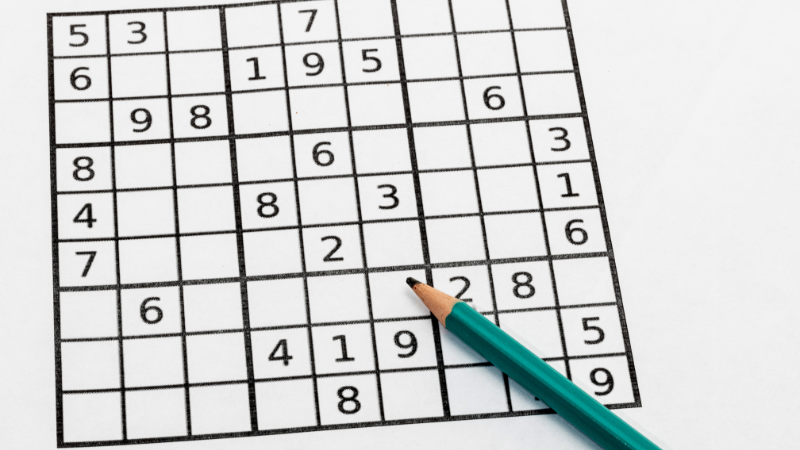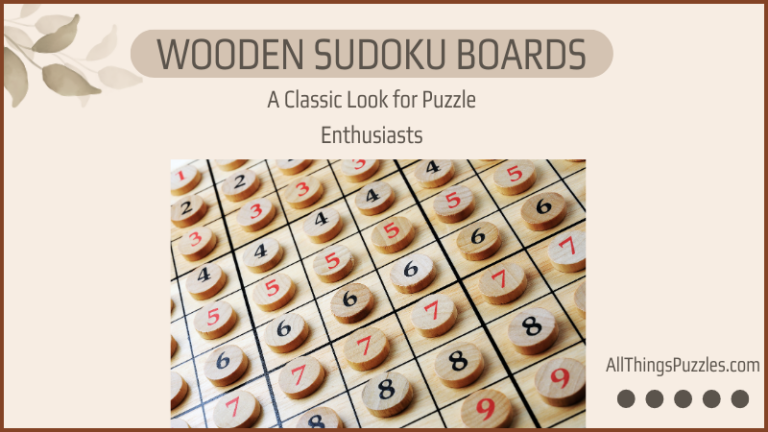Sudoku puzzles have captured the hearts and minds of puzzle enthusiasts worldwide. The addictive nature of these number-placement puzzles keeps people engaged for hours on end. But have you ever wondered about the history of Sudoku? How did it evolve into the captivating game we know today? In this article, we’ll take a journey through time to explore the origins and development of Sudoku.
Sudoku Origins
To understand the roots of Sudoku, we need to go back in time to ancient civilizations. Similar number placement puzzles can be found in various cultures throughout history.
Magic Squares
For instance, while the modern version of Sudoku we know today did not originate in China, there are historical number placement puzzles in ancient Chinese culture that share similarities with Sudoku.
One such puzzle is the Magic Square, which dates back thousands of years in Chinese history. The Magic Square involves arranging numbers in a square grid such that each row, column, and diagonal adds up to the same sum. These magic squares were not only seen as entertaining puzzles but also held symbolic and mystical significance in Chinese culture.
The earliest known Magic Squares in China can be traced back to the legendary Emperor Yu, who lived around 2200 BCE. According to Chinese mythology, Emperor Yu created a 3×3 Magic Square called the Lo Shu Square. The Lo Shu Square is said to have been discovered on the back of a turtle emerging from the Yellow River. This 3×3 grid contains the numbers 1 to 9, arranged in a way that the sum of each row, column, and diagonal equals 15.
While the Magic Square is not the same as modern Sudoku, it shares the concept of arranging numbers in a grid without repetition and having certain sums. The Magic Square tradition continued in Chinese mathematics and folklore, with larger square grids and more complex rules developed over time.
It’s worth noting that the direct lineage between ancient Chinese number placement puzzles and modern Sudoku is not clear. Sudoku, as we know it today, evolved independently in the 18th century and gained popularity in Switzerland and Japan. However, the influence of ancient number placement puzzles like the Magic Square in various cultures, including China, may have contributed to the development of logical and pattern-based puzzles over time.
Latin Squares
Similarly, in 18th-century Europe, Latin Squares presented a similar concept of filling grids with unique numbers without repetition.
A Latin square is an arrangement of numbers or symbols in a grid, such that each element appears exactly once in each row and each column. In other words, no number or symbol is repeated within a row or a column. Latin squares are named after their connection to Latin squares in mathematical combinatorial designs.
Latin squares have a rich history and can be traced back to the 18th century. They were first studied by the Swiss mathematician Leonhard Euler, who investigated various properties and applications of these squares.
One interesting property of Latin squares is that they can be used to create Sudoku-like puzzles. In fact, the initial inspiration for Sudoku can be traced back to Euler’s work on Latin squares. Euler’s studies on the placement of numbers in grids without repetition provided the foundation for the logical reasoning and patterns involved in solving Sudoku puzzles.
Modern Sudoku Emerges

As we move through the Sudoku history we come to the modern version of Sudoku as we know it today can be traced back to Switzerland and Japan. In the 18th century, Swiss mathematician Leonhard Euler made significant contributions to the development of Sudoku through his work on Latin Squares. Euler’s studies laid the foundation for the logical reasoning and patterns involved in solving Sudoku puzzles.
Fast forward to the 20th century, when Japan played a crucial role in refining and popularizing Sudoku. Puzzle magazines in Japan began publishing number-placement puzzles, introducing the game to a broader audience. During this time, Sudoku gained its name, which translates to “single number” or “number alone.” The logical and strategic nature of Sudoku quickly captivated puzzle enthusiasts across Japan.
Sudoku Goes Global

The actual global explosion of Sudoku puzzles began in the early 2000s. Wayne Gould, a retired New Zealand judge, played a pivotal role in popularizing Sudoku outside of Japan. After encountering Sudoku during a trip to Tokyo, Gould became obsessed with the puzzle. He spent years developing a computer program capable of generating Sudoku puzzles with unique solutions.
Gould’s efforts paid off when he managed to get his Sudoku puzzles published in international newspapers and puzzle books. The inclusion of Sudoku in popular publications, combined with the rising popularity of the internet, led to an exponential growth in its global fan base. Sudoku quickly became a household name, captivating puzzle enthusiasts of all ages and backgrounds.
Sudoku Variations and Innovations
As Sudoku gained popularity worldwide, puzzle creators began introducing variations to add complexity and excitement to the game. Samurai Sudoku, for instance, takes Sudoku to a whole new level by combining five overlapping grids, each with its own unique solution. Killer Sudoku introduces mathematical operations and sum constraints, challenging players to calculate and place numbers strategically.
In the digital era, technology has opened up new possibilities for Sudoku. Interactive Sudoku apps and online communities have allowed for creating and sharing of an endless variety of Sudoku puzzles. The availability of different levels of difficulty and the ability to compete with other players worldwide have made Sudoku an even more dynamic and engaging puzzle experience.
Sudoku Competitions and Achievements
World Sudoku Championship: The World Sudoku Championship is an annual event where participants from different countries compete to solve a series of challenging Sudoku puzzles. This competition showcases the skills and speed of top Sudoku solvers from around the globe.
Guinness World Records: The Guinness World Records recognizes various Sudoku-related achievements. These records include categories such as the fastest time to complete a Sudoku puzzle, the most puzzles solved in a certain timeframe, and the largest Sudoku grid ever created. These records highlight exceptional performances and milestones in the world of Sudoku.
Puzzle Solving Competitions: Besides the World Sudoku Championship, there are numerous puzzle-solving competitions and events where Sudoku plays a prominent role. These events often feature timed Sudoku challenges, team competitions, and even marathon-solving sessions, pushing participants to demonstrate their skills under pressure.
Puzzle Solving Apps and Platforms: In the digital realm, there are online platforms and mobile apps that provide a platform for Sudoku enthusiasts to compete and showcase their solving abilities. These platforms may offer leaderboards, timed challenges, and achievements, fostering a competitive environment for Sudoku enthusiasts to test their skills against others.
Playing Suduko

Playing Sudoku is a fun and engaging puzzle-solving activity. Here’s a step-by-step guide on how to play Sudoku:
Understand the Grid: Sudoku is played on a 9×9 grid, divided into nine 3×3 sub-grids called boxes or regions. The goal is to fill the grid with numbers from 1 to 9 so that each row, column, and box contains all the numbers without any repetition.
Start with the Clues: A Sudoku puzzle begins with some numbers already filled in as clues. These numbers provide a starting point for solving the puzzle. Take note of these initial clues as they give you information about the placement of numbers.
Fill in the Missing Numbers: Your task is to fill in the remaining empty squares in the grid with numbers from 1 to 9. Each row, column, and box must contain all the numbers exactly once.
Follow the Rules: The rules of Sudoku are simple:
- Each row must contain all the numbers from 1 to 9 without repetition.
- Each column must contain all the numbers from 1 to 9 without repetition.
- Each box must contain all the numbers from 1 to 9 without repetition.
Use Logic and Deduction: To solve Sudoku; you need to apply logical thinking and deduction. Start by looking for easy deductions, such as identifying numbers that can only go in one particular square within a row, column, or box. Use the process of elimination to narrow down the possibilities for each square based on the numbers already filled in.
Eliminate Possibilities: As you fill in numbers, eliminate the possibilities for the empty squares in the same row, column, or box. Cross off numbers that are already present in a particular row, column, or box to help you identify the remaining possibilities.
Repeat and Iterate: Continue filling in numbers and making logical deductions until you complete the entire grid. Remember to check for conflicts and ensure that each row, column, and box contains all the numbers from 1 to 9.
Practice and Enjoy: Sudoku improves with practice. The more puzzles you solve, the better you’ll become at recognizing patterns, applying strategies, and finding efficient solutions. Enjoy the process and challenge yourself with puzzles of varying difficulty levels.
FAQS
Can Sudoku help improve mental agility and brain health?
Yes, solving Sudoku puzzles can be beneficial for mental agility and brain health. Sudoku requires logical thinking, pattern recognition, and problem-solving skills, all of which help exercise and stimulate the brain. Regularly engaging in Sudoku puzzles can improve cognitive abilities, memory, and concentration.
Is there only one correct answer in Sudoku?
Yes, in a standard Sudoku puzzle, there is only one correct solution. When the puzzle is designed properly, there should be a unique solution that can be reached through logical reasoning and elimination. This uniqueness ensures that there is only one correct arrangement of numbers that satisfies all the given conditions.
What is the average time it takes to solve a Sudoku puzzle?
The average Sudoku solver time can vary widely depending on several factors, including the difficulty level of the puzzle, the solver’s experience and skill level, and individual solving strategies. It’s challenging to determine an exact average solver time since it can range from a few minutes to over an hour, depending on these variables.
To give an idea, though, for experienced solvers, an easy or beginner-level Sudoku puzzle may be completed in a relatively short time, such as 5 to 10 minutes or even less. Intermediate-level puzzles might take anywhere from 10 to 30 minutes, while harder puzzles can take significantly longer.
Where did Sudoku originate?
The origins of Sudoku, the popular number puzzle game, originated in Switzerland, not in Japan as many people commonly believe. The puzzle was first introduced by Swiss mathematician Leonhard Euler in the 18th century. Euler created a puzzle called “Latin Squares,” which was a precursor to the modern Sudoku we know today.
However, Sudoku as we know it now with a 9×9 grid divided into nine 3×3 subgrids (also known as regions) and filled with numbers from 1 to 9, became popular in Japan in the 20th century.
Additional Reading
Conclusion
By delving into the history of Sudoku, its evolution, and its variations, we can appreciate the rich history behind this captivating puzzle. From its ancient roots in different cultures to its modern-day global popularity, Sudoku continues to intrigue and engage puzzle enthusiasts of all ages. So, the next time you pick up a Sudoku puzzle, you’ll have a deeper understanding of the fascinating journey that led to its creation. Happy solving!
Remember, the key to mastering Sudoku lies in practice, patience, and a passion for logical problem-solving. So, grab a pen and immerse yourself in the fascinating world of Sudoku puzzles!





